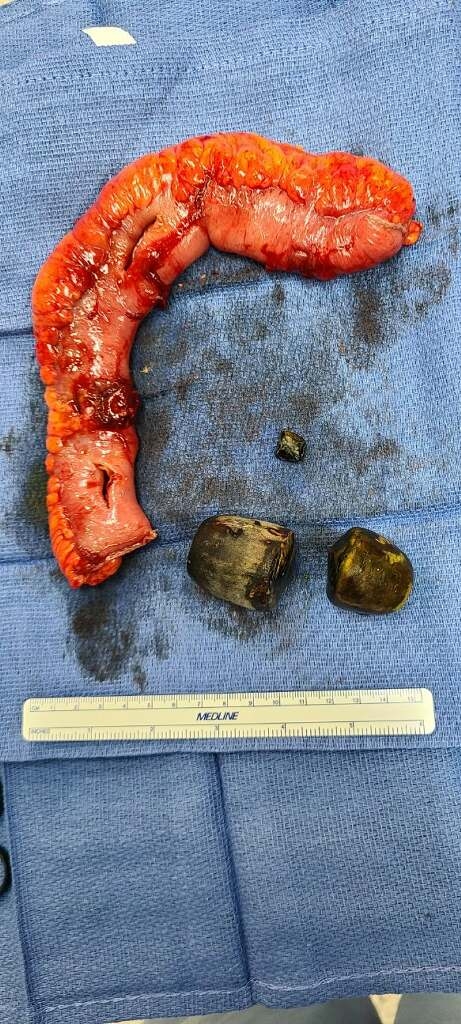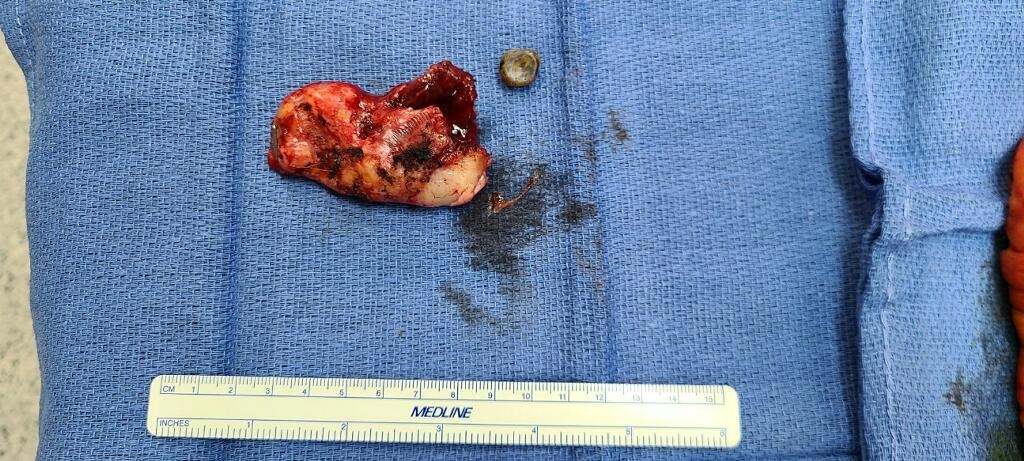GALLSTONE ILEUS IN THE SETTING OF CHOLECYSTOJEJUNAL FISTULA: A UNIQUE CAUSE OF MECHANICAL SMALL BOWEL OBSTRUCTION
Christopher Pearcy*2, Maitham A. Moslim1, Michael Jureller1
1Hepatopancreatobiliary Surgery, Methodist Richardson Medical Center, Richardson, TX; 2Methodist Dallas Medical Center, Dallas, TX
Gallstone ileus is a rare cause of small bowel obstruction representing 0.5% of all mechanical causes. It occurs when a fistula develops between the gallbladder and duodenum. Cholecystogastric and cholecystocolonic fistulas also occur. Here we present a case of a small bowel obstruction from gallstone ileus from cholecystojejunal fistula.
A 58-year-old male presented to our hospital with 5-day history of nausea, vomiting, and right sided abdominal pain. Vital signs were normal and stable. Lab work was unremarkable. Imaging demonstrated small bowel obstruction with two large gall stones in the distal small bowel, pneumobilia, and fistulous connection between the gallbladder and jejunum. His past history included laparoscopic sigmoid colectomy for complicated diverticulitis five months prior with leak requiring open washout and diverting loop ileostomy. The patient noticed passage of a very small green stone into his ileostomy bag during the recovery period. He developed acute cholecystitis and he underwent cholecystostomy tube placement (C-tube). He recovered and the tube was removed in September. In October, his ileostomy was reversed without complication. We then took the patient to the operating room after resuscitation and nasogastric decompression. We performed an exploratory laparotomy and noted a loop of small bowel tethered to the gallbladder. On either side of this loop were two large gallstones occupying the entire lumen of small bowel causing obstruction. There was neither significant inflammation of the gallbladder nor significant adhesions. We elected to perform a fistula takedown with segmental small bowel resection (including the obstructing stones) and cholecystectomy. The patient did well postoperatively and was discharged on post-operative day 5 after return of bowel function.
Here we present a rare case of cholecystojejunal fistula leading to gallstone ileus. The normal pathogenesis of gallstone ileus is described as calculous cholecystitis causing inflammation and pressure necrosis of the adjacent duodenum. The jejunum is rarely involved as it is typically situated away from the gallbladder and protected by the mesocolon and transverse colon. We hypothesize that the altered anatomy from this recent surgery led to cholecystojejunal fistula formation in the setting of cholecystitis. We considered iatrogenic cause from the cholecystostomy tube, but patient mentioned the passage of stones into his ileostomy bag prior to placement of the tube. Traditionally, gallstone ileus should be managed with proximal enterotomy, retrograde passage and extraction of the stone, and closure of the enterotomy. The fistula should be left alone to avoid damage to the. In our case, there was minimal residual inflammation which allowed us to perform fistula takedown and cholecystectomy safely at index operation.

Back to 2022 Posters
